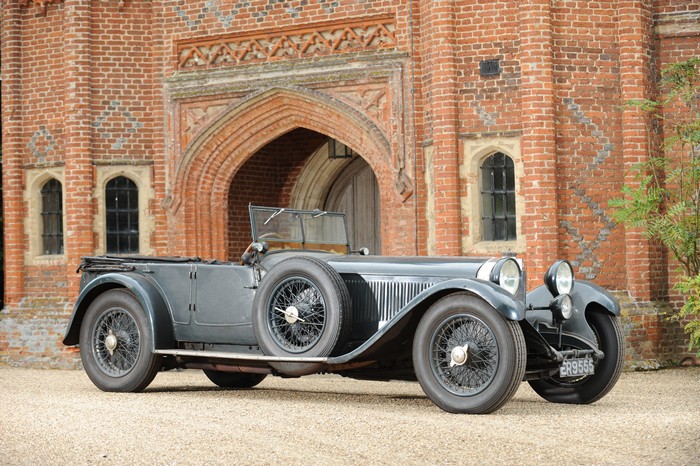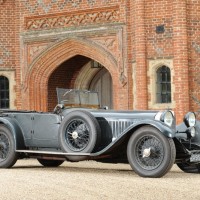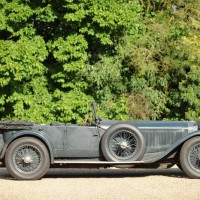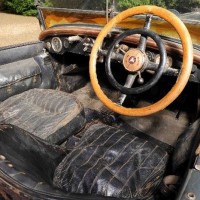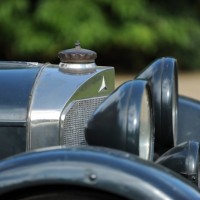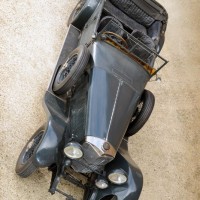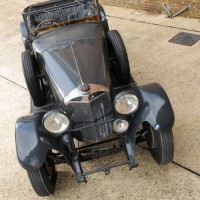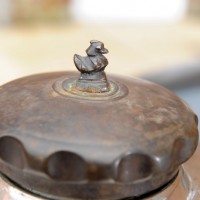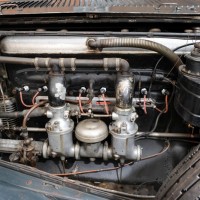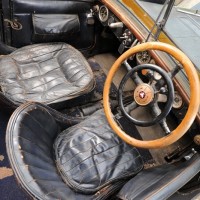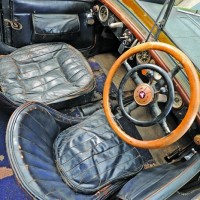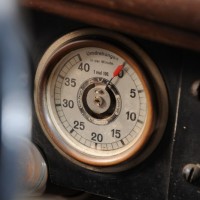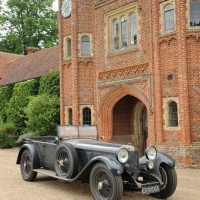This extraordinary S-type has been preserved within its very first family ownership for no fewer than the past 84 years. The original owner was a former military captain who had the rare distinction for a British Army officer of having served throughout (and survived) World War I. He ordered the S-type on February 28, 1928, from The British Mercedes Limited and commissioned Cadogan Motors Ltd. to create and fit a lightweight fabric-skinned body to his specification.
It was very similar to the Sindelfingen factory bodies but promised to be lighter, and the captain’s London home (now demolished) was in Curzon Street in Mayfair, so Cadogan’s workshop in Chelsea was just around the corner.
The captain made a number of modifications to the car, matching it to his personal preferences. In, we believe, 1931, the standard gearbox was replaced by a British ENV/Armstrong-Siddeley-type Wilson pre-selector gearbox, with gear selection from a neat quadrant control in the center of the dashboard. The mid-ships chassis cross-brace was revised and re-sited to accommodate this change. A steering damper was also adopted, being mounted diagonally beneath the front dumb-irons.
The captain decided that such a special motor car deserved and required garaging within a dedicated motor house, and so at his country residence he had such a building custom made for the car. From around 1931 until 2012, this Mercedes-Benz has been accommodated within this tailor-made building.
The captain used this Mercedes-Benz quite sparingly during his ownership, seemingly considering it proper transport essentially for high days and holidays. But he died on May 28, 1940, at the tragically early age of 47. Ownership of the Mercedes-Benz then passed to his 10-year-old son.
In the 1950s, still with very little mileage completed, the car was put up on blocks, where it rested until 2012, when ownership of the car passed to the captain’s grandson. He revived the old Mercedes-Benz — with typical family discretion, in secret, without his father’s knowledge — to running order, in time for his parent’s 75th birthday.
The car was secretly entrusted to specialist Alan Hancock, who had been contacted upon private recommendation from a family friend and collector, and it proved to run incredibly well, ticking over with jaw-dropping silence and driving very nicely, although the aged exhaust system provides understandably unrefined accompaniment at higher engine speeds.
Subsequently, the owner replaced the back-axle drive gear; a German source was located that could machine a new replacement from steel, complying with the period-correct grade and treatment.
A Daimler-Benz Classic factory engineer conducted a non-invasive, non-destructive inspection of ER 9555 as offered here. The resultant factory report — in which component serials have been checked against original period archive records — confirms the car’s originality.
SCM Analysis
Detailing
| Vehicle: | 1928 Mercedes-Benz 36/220 S-Type Open Tourer |
| Number Produced: | 146 |
| Original List Price: | $7,000 (chassis only) |
| Tune Up Cost: | $4,000 |
| Chassis Number Location: | Right side of scuttle and various other stampings about chassis |
| Engine Number Location: | Rear left engine mount |
| Club Info: | Mercedes-Benz Club of America |
| Website: | http://www.mbca.org |
This car, Lot 108, sold for $4,543,394, including buyer’s premium, at Bonhams’ Goodwood Revival sale on September 15, 2012.
Bonhams made much of the car’s originality in the catalog, thus: “At the highest level of connoisseurial interest in Vintage, classic and historic cars, it has long been appreciated that restoration is itself a process of obliteration. Once originality has been discarded or painted-over, it can never ever be retrieved. While class is permanent, condition is temporary. As the world’s stock of surviving as-original cars has diminished, so we see an increasingly concerned core of informed and discerning enthusiasts, collectors and institutions seeking surviving cars from this diminishing treasury. By the laws of increasing demand versus diminishing supply, these achingly-rare Mona Lisas of the automotive world are intensely desirable assets.”
A few in-period changes
We love originality — but this car was almost grungy. That didn’t matter. Neither, apparently, did the fact that the original gearbox had been replaced with a British preselector unit (wherein you move the lever to the next ratio you want but the transmission doesn’t shift until you dip the clutch — very handy for one-armed racers). That necessitated a new crossmember to mount it, and that also meant moving back the starter motor, which sits back on the transmission tunnel on long spacers.
The captain also did not care for the outside exhausts, so these were shorn and replaced with a more discreet internal system. He also didn’t like the Mercedes-Benz three-pointed star, which he felt was ostentatious, especially between two World Wars in Europe, the first of which he was party to. And clouds were gathering for the second one, so this was replaced with a small brass duck, which is still on the car.
A meticulous man, he also fitted a Tapley brake performance meter, which is still on the back of the windscreen, and felt that the steering would benefit from a damper, which remains on the car.
Due to the captain’s early death, the car lay dormant for much if its life. It was road-taxed continuously from 1928 to the end of 1937 — there is a note referring to a Royal Automobile Club Touring Department International Fiscal Permit on April 29, 1937, strongly suggesting touring use abroad, probably in Continental Europe — and its last taxation period prior to its recommissioning expired in September 1952.
Most of the instruments are original, including the Junghans clock, but the oil pressure gauge is likely not, and it is probably a later, British-sourced replacement. A non-standard British Teleflex damper-adjustment control was another of the captain’s preferences.
Otherwise, this car it is almost untouched — thanks to more than 50 years in storage, and that includes the metal-cased tools, and spares in velvet-lined boxes.
When the car was re-commissioned to run under its own steam, the tires were replaced, and there is evidence that someone has been in the engine, with new plug wires an indication. When Mercedes-Benz came to inspect the car, there was some sympathetic dismantling, where they found that it runs a hotter camshaft from an SS or SSK (beautifully inscribed No 248) in the name of more torque — such that you need with almost seven liters of twin-carbed, supercharged straight six engine on board.
S-types, designed by Dr. Porsche, have always had a devoted following, partly due to their exclusive rarity — but also because of their massive performance from elephantine grunt, enhanced by that legendary whine when the blower engaged on full throttle. Later, the competition success of the SS and shorter SSK (this car, by the way, was not raced at Brooklands, as the British newspapers had it in the days after the sale, but merely speed-tested there, in the days before motorways or autobahns) also increased their value. So, to meet one as untouched and original as this, 84 years after it was made, is a little spooky, and I’ll bet it’s still a thrill to drive.
The body, with its beautiful patina, is all intact; the leather is considerably worn but not actually distressed, and the carpets and seat backs are moth-eaten. The fabric body has survived, but the paint is cracked. The radiator plating would probably polish back, and the beautiful engine-turning is still visible on the cam cover. The fantastic history includes original old-style logbooks and notes from the first owner.
This was just about the best of the best, and knocked down to “a representative of a major European collection,” who outbid at least five others to a price almost double the pre-sale estimate. The price would no doubt have been even higher had the 1920s coachwork been made in Sindelfingen, rather than in London by Cadogan.
The supercar of its day
Remember, this is pretty much a racing car on the road, the McLaren F1 of its day, sharing much of the running gear with the legendary SSK. Except that this car is even rarer.
The last of its type to sell, chassis 35218, with a sportier body, fetched $5,040,000 in “faultlessly restored”` condition at Gooding’s 2011 Pebble Beach auction. This car fetched just about as much in real terms, in original nick.
The question is, what do you do with it now? Restoring it would take away the very originality that makes it so valuable.
With under 9,000 miles under its wheels, it’s hardly run in, and it has been gone through to make it a runner. Engineered like a truck, it’s just about indestructible and it can’t get much tattier. It might be a forlorn wish, but the obvious course of action is for the new owner to smoke it around the world for us all to enjoy. Pebble Beach Tour d’Elegance (and, if only we can hope, the Mille Miglia), here it comes. ?
(Introductory description courtesy of Bonhams.)
